Volvo's Business Model: Innovation and Sustainable Development
VerifiedAdded on 2024/05/21
|8
|2090
|314
Essay
AI Summary
This essay analyzes Volvo's business model, focusing on innovation and sustainable business development. It examines the opportunities and threats presented by smart connected products, particularly Ericsson's Cloud Connected Service. The analysis uses Osterwalder & Pigneur's business model canvas to illustrate Volvo's customer segments, value proposition, channels, customer relationships, revenue streams, key resources, key activities, key partnerships, and cost structure. The essay further explores Volvo's business model from the perspective of value proposition and its capabilities and resources, concluding that a well-planned business model is crucial for achieving strategic goals and gaining a competitive edge through innovation and disruption.
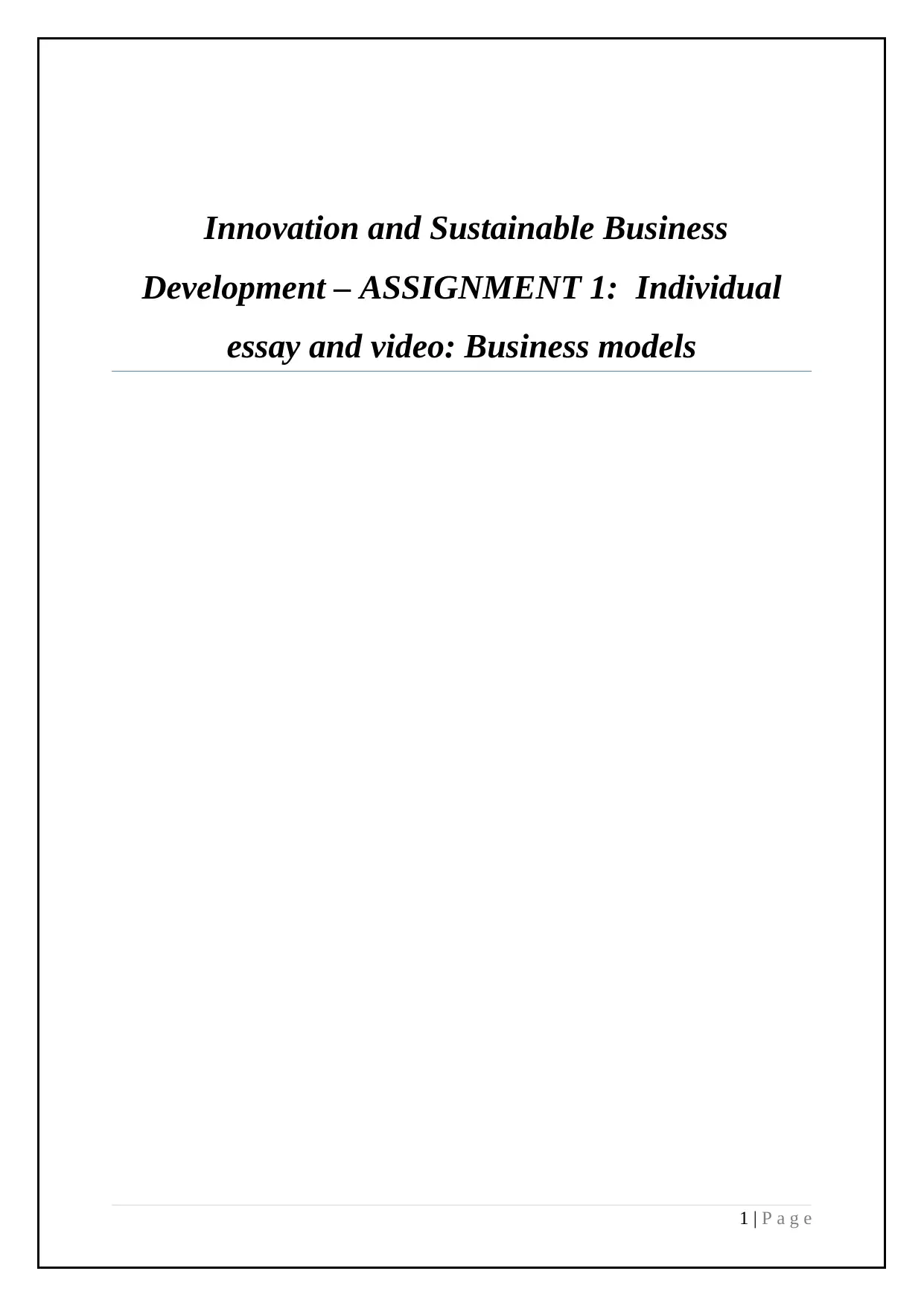
Innovation and Sustainable Business
Development – ASSIGNMENT 1: Individual
essay and video: Business models
1 | P a g e
Development – ASSIGNMENT 1: Individual
essay and video: Business models
1 | P a g e
Paraphrase This Document
Need a fresh take? Get an instant paraphrase of this document with our AI Paraphraser
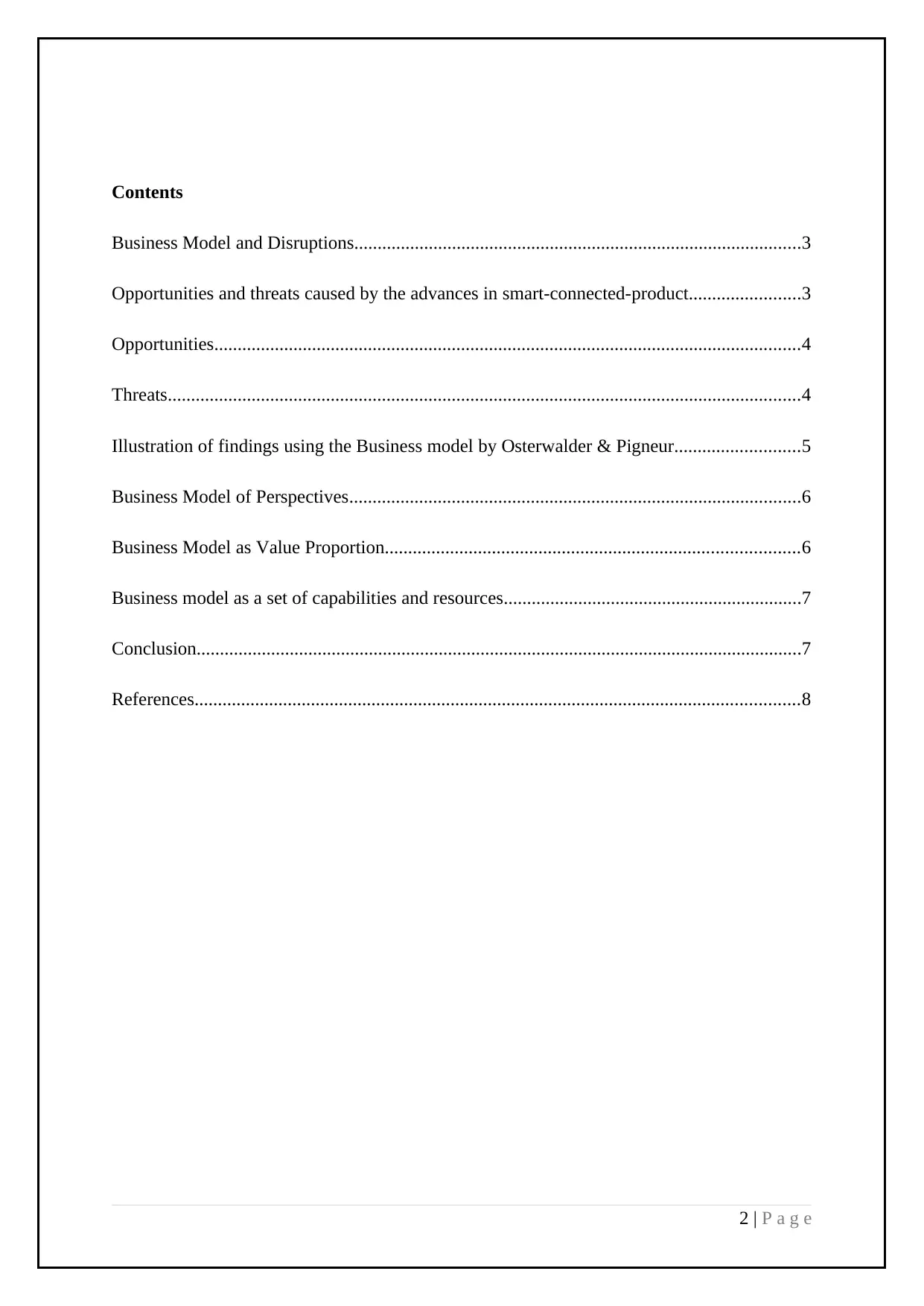
Contents
Business Model and Disruptions................................................................................................3
Opportunities and threats caused by the advances in smart-connected-product........................3
Opportunities..............................................................................................................................4
Threats........................................................................................................................................4
Illustration of findings using the Business model by Osterwalder & Pigneur...........................5
Business Model of Perspectives.................................................................................................6
Business Model as Value Proportion.........................................................................................6
Business model as a set of capabilities and resources................................................................7
Conclusion..................................................................................................................................7
References..................................................................................................................................8
2 | P a g e
Business Model and Disruptions................................................................................................3
Opportunities and threats caused by the advances in smart-connected-product........................3
Opportunities..............................................................................................................................4
Threats........................................................................................................................................4
Illustration of findings using the Business model by Osterwalder & Pigneur...........................5
Business Model of Perspectives.................................................................................................6
Business Model as Value Proportion.........................................................................................6
Business model as a set of capabilities and resources................................................................7
Conclusion..................................................................................................................................7
References..................................................................................................................................8
2 | P a g e
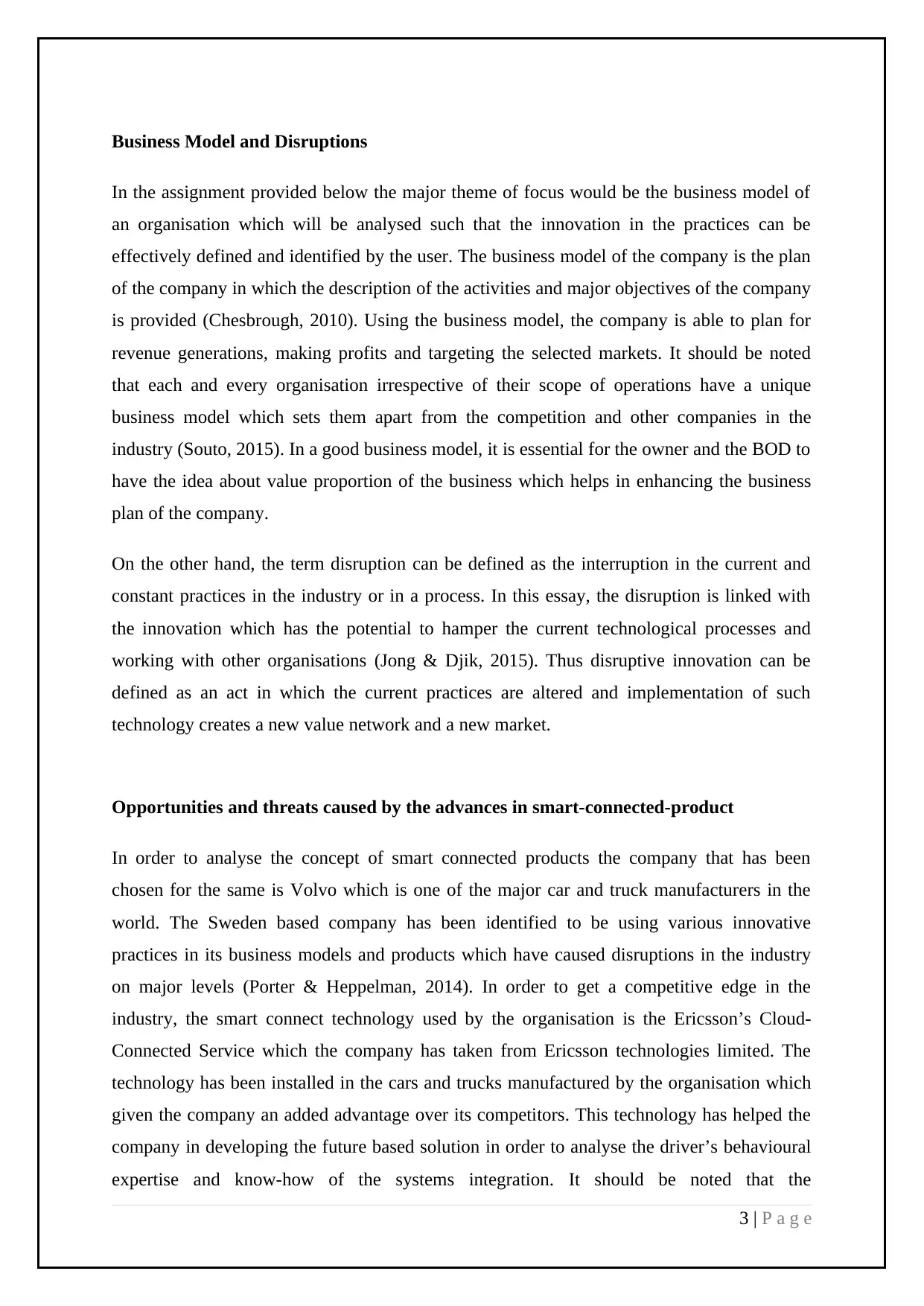
Business Model and Disruptions
In the assignment provided below the major theme of focus would be the business model of
an organisation which will be analysed such that the innovation in the practices can be
effectively defined and identified by the user. The business model of the company is the plan
of the company in which the description of the activities and major objectives of the company
is provided (Chesbrough, 2010). Using the business model, the company is able to plan for
revenue generations, making profits and targeting the selected markets. It should be noted
that each and every organisation irrespective of their scope of operations have a unique
business model which sets them apart from the competition and other companies in the
industry (Souto, 2015). In a good business model, it is essential for the owner and the BOD to
have the idea about value proportion of the business which helps in enhancing the business
plan of the company.
On the other hand, the term disruption can be defined as the interruption in the current and
constant practices in the industry or in a process. In this essay, the disruption is linked with
the innovation which has the potential to hamper the current technological processes and
working with other organisations (Jong & Djik, 2015). Thus disruptive innovation can be
defined as an act in which the current practices are altered and implementation of such
technology creates a new value network and a new market.
Opportunities and threats caused by the advances in smart-connected-product
In order to analyse the concept of smart connected products the company that has been
chosen for the same is Volvo which is one of the major car and truck manufacturers in the
world. The Sweden based company has been identified to be using various innovative
practices in its business models and products which have caused disruptions in the industry
on major levels (Porter & Heppelman, 2014). In order to get a competitive edge in the
industry, the smart connect technology used by the organisation is the Ericsson’s Cloud-
Connected Service which the company has taken from Ericsson technologies limited. The
technology has been installed in the cars and trucks manufactured by the organisation which
given the company an added advantage over its competitors. This technology has helped the
company in developing the future based solution in order to analyse the driver’s behavioural
expertise and know-how of the systems integration. It should be noted that the
3 | P a g e
In the assignment provided below the major theme of focus would be the business model of
an organisation which will be analysed such that the innovation in the practices can be
effectively defined and identified by the user. The business model of the company is the plan
of the company in which the description of the activities and major objectives of the company
is provided (Chesbrough, 2010). Using the business model, the company is able to plan for
revenue generations, making profits and targeting the selected markets. It should be noted
that each and every organisation irrespective of their scope of operations have a unique
business model which sets them apart from the competition and other companies in the
industry (Souto, 2015). In a good business model, it is essential for the owner and the BOD to
have the idea about value proportion of the business which helps in enhancing the business
plan of the company.
On the other hand, the term disruption can be defined as the interruption in the current and
constant practices in the industry or in a process. In this essay, the disruption is linked with
the innovation which has the potential to hamper the current technological processes and
working with other organisations (Jong & Djik, 2015). Thus disruptive innovation can be
defined as an act in which the current practices are altered and implementation of such
technology creates a new value network and a new market.
Opportunities and threats caused by the advances in smart-connected-product
In order to analyse the concept of smart connected products the company that has been
chosen for the same is Volvo which is one of the major car and truck manufacturers in the
world. The Sweden based company has been identified to be using various innovative
practices in its business models and products which have caused disruptions in the industry
on major levels (Porter & Heppelman, 2014). In order to get a competitive edge in the
industry, the smart connect technology used by the organisation is the Ericsson’s Cloud-
Connected Service which the company has taken from Ericsson technologies limited. The
technology has been installed in the cars and trucks manufactured by the organisation which
given the company an added advantage over its competitors. This technology has helped the
company in developing the future based solution in order to analyse the driver’s behavioural
expertise and know-how of the systems integration. It should be noted that the
3 | P a g e
⊘ This is a preview!⊘
Do you want full access?
Subscribe today to unlock all pages.

Trusted by 1+ million students worldwide
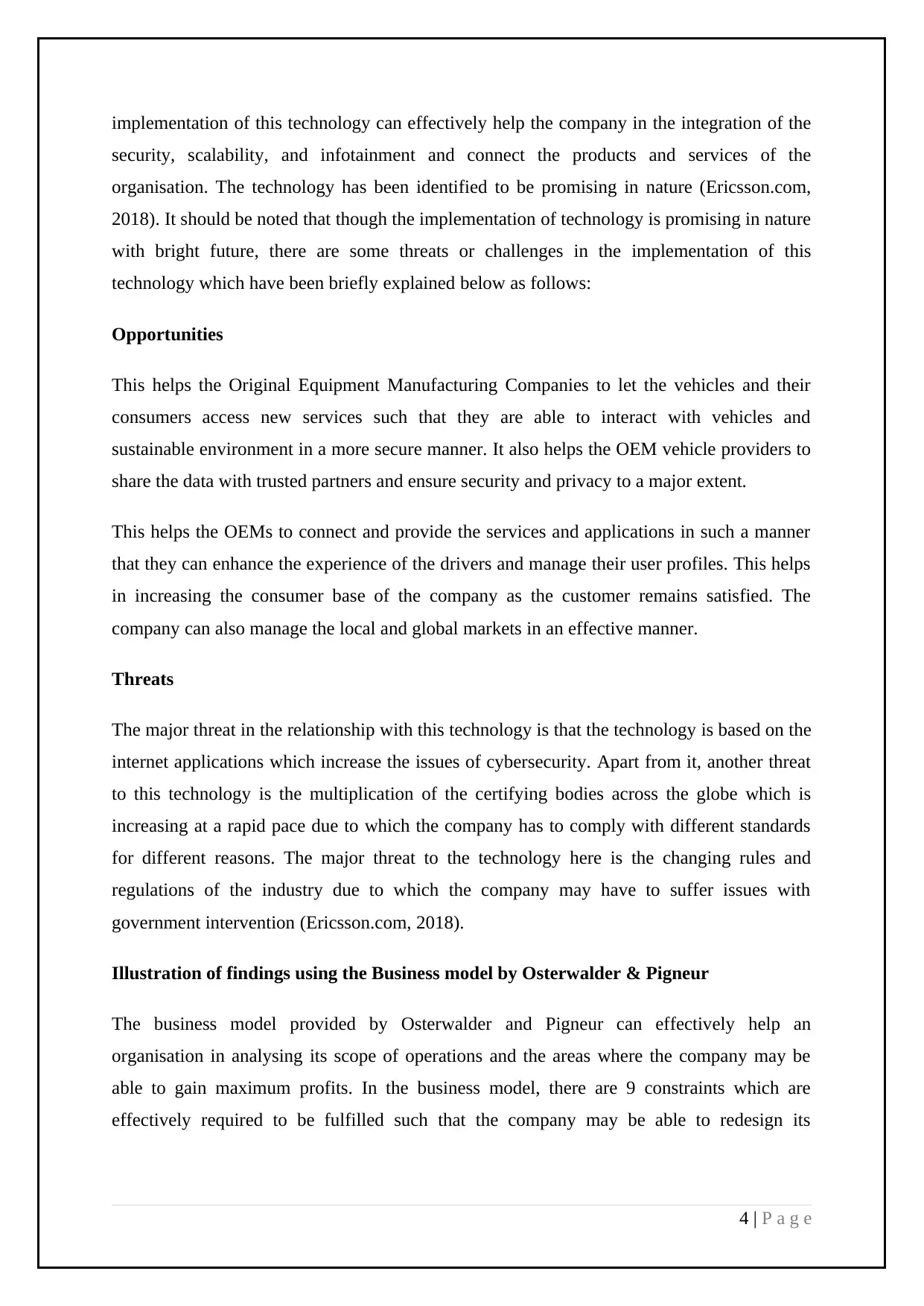
implementation of this technology can effectively help the company in the integration of the
security, scalability, and infotainment and connect the products and services of the
organisation. The technology has been identified to be promising in nature (Ericsson.com,
2018). It should be noted that though the implementation of technology is promising in nature
with bright future, there are some threats or challenges in the implementation of this
technology which have been briefly explained below as follows:
Opportunities
This helps the Original Equipment Manufacturing Companies to let the vehicles and their
consumers access new services such that they are able to interact with vehicles and
sustainable environment in a more secure manner. It also helps the OEM vehicle providers to
share the data with trusted partners and ensure security and privacy to a major extent.
This helps the OEMs to connect and provide the services and applications in such a manner
that they can enhance the experience of the drivers and manage their user profiles. This helps
in increasing the consumer base of the company as the customer remains satisfied. The
company can also manage the local and global markets in an effective manner.
Threats
The major threat in the relationship with this technology is that the technology is based on the
internet applications which increase the issues of cybersecurity. Apart from it, another threat
to this technology is the multiplication of the certifying bodies across the globe which is
increasing at a rapid pace due to which the company has to comply with different standards
for different reasons. The major threat to the technology here is the changing rules and
regulations of the industry due to which the company may have to suffer issues with
government intervention (Ericsson.com, 2018).
Illustration of findings using the Business model by Osterwalder & Pigneur
The business model provided by Osterwalder and Pigneur can effectively help an
organisation in analysing its scope of operations and the areas where the company may be
able to gain maximum profits. In the business model, there are 9 constraints which are
effectively required to be fulfilled such that the company may be able to redesign its
4 | P a g e
security, scalability, and infotainment and connect the products and services of the
organisation. The technology has been identified to be promising in nature (Ericsson.com,
2018). It should be noted that though the implementation of technology is promising in nature
with bright future, there are some threats or challenges in the implementation of this
technology which have been briefly explained below as follows:
Opportunities
This helps the Original Equipment Manufacturing Companies to let the vehicles and their
consumers access new services such that they are able to interact with vehicles and
sustainable environment in a more secure manner. It also helps the OEM vehicle providers to
share the data with trusted partners and ensure security and privacy to a major extent.
This helps the OEMs to connect and provide the services and applications in such a manner
that they can enhance the experience of the drivers and manage their user profiles. This helps
in increasing the consumer base of the company as the customer remains satisfied. The
company can also manage the local and global markets in an effective manner.
Threats
The major threat in the relationship with this technology is that the technology is based on the
internet applications which increase the issues of cybersecurity. Apart from it, another threat
to this technology is the multiplication of the certifying bodies across the globe which is
increasing at a rapid pace due to which the company has to comply with different standards
for different reasons. The major threat to the technology here is the changing rules and
regulations of the industry due to which the company may have to suffer issues with
government intervention (Ericsson.com, 2018).
Illustration of findings using the Business model by Osterwalder & Pigneur
The business model provided by Osterwalder and Pigneur can effectively help an
organisation in analysing its scope of operations and the areas where the company may be
able to gain maximum profits. In the business model, there are 9 constraints which are
effectively required to be fulfilled such that the company may be able to redesign its
4 | P a g e
Paraphrase This Document
Need a fresh take? Get an instant paraphrase of this document with our AI Paraphraser
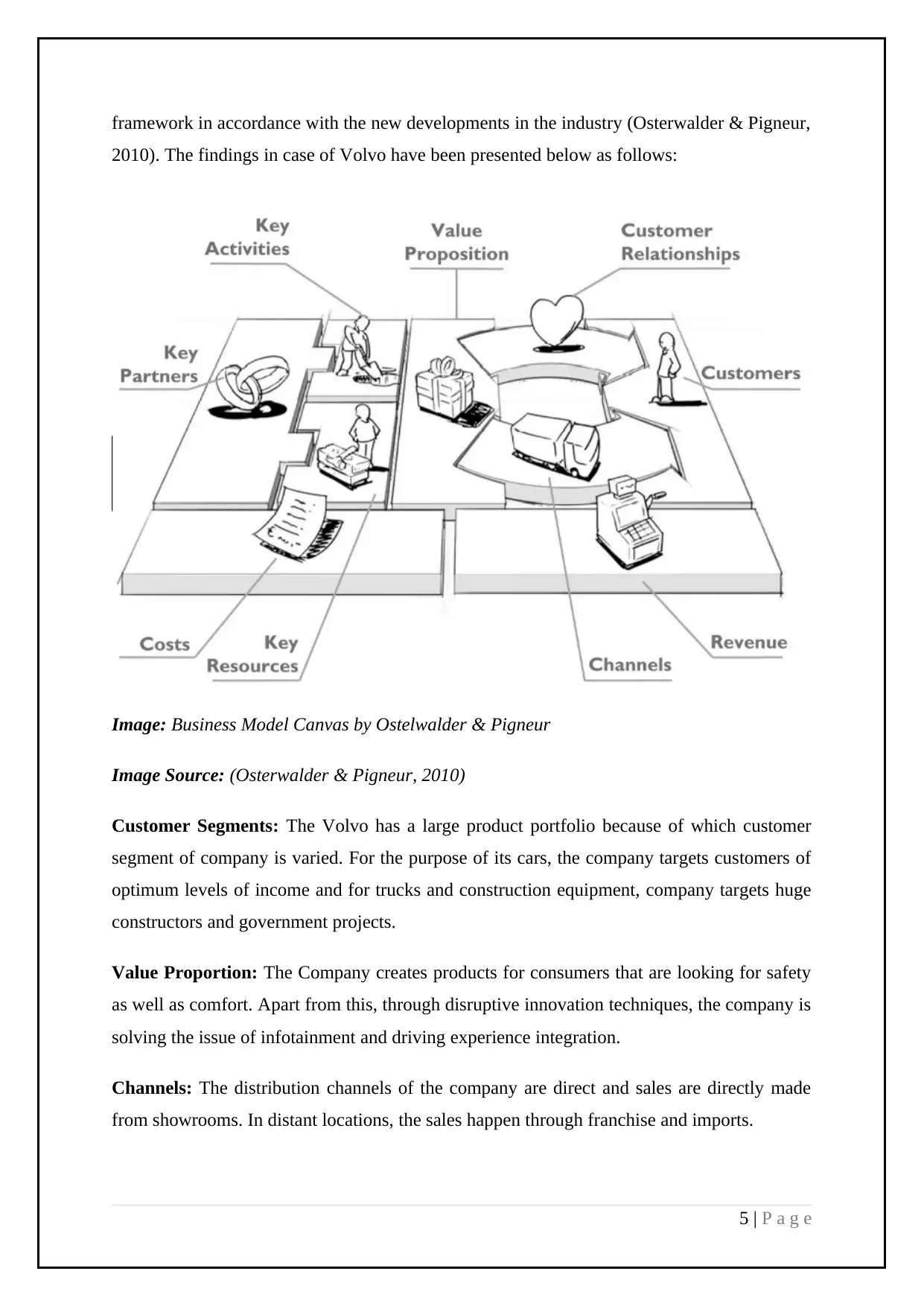
framework in accordance with the new developments in the industry (Osterwalder & Pigneur,
2010). The findings in case of Volvo have been presented below as follows:
Image: Business Model Canvas by Ostelwalder & Pigneur
Image Source: (Osterwalder & Pigneur, 2010)
Customer Segments: The Volvo has a large product portfolio because of which customer
segment of company is varied. For the purpose of its cars, the company targets customers of
optimum levels of income and for trucks and construction equipment, company targets huge
constructors and government projects.
Value Proportion: The Company creates products for consumers that are looking for safety
as well as comfort. Apart from this, through disruptive innovation techniques, the company is
solving the issue of infotainment and driving experience integration.
Channels: The distribution channels of the company are direct and sales are directly made
from showrooms. In distant locations, the sales happen through franchise and imports.
5 | P a g e
2010). The findings in case of Volvo have been presented below as follows:
Image: Business Model Canvas by Ostelwalder & Pigneur
Image Source: (Osterwalder & Pigneur, 2010)
Customer Segments: The Volvo has a large product portfolio because of which customer
segment of company is varied. For the purpose of its cars, the company targets customers of
optimum levels of income and for trucks and construction equipment, company targets huge
constructors and government projects.
Value Proportion: The Company creates products for consumers that are looking for safety
as well as comfort. Apart from this, through disruptive innovation techniques, the company is
solving the issue of infotainment and driving experience integration.
Channels: The distribution channels of the company are direct and sales are directly made
from showrooms. In distant locations, the sales happen through franchise and imports.
5 | P a g e
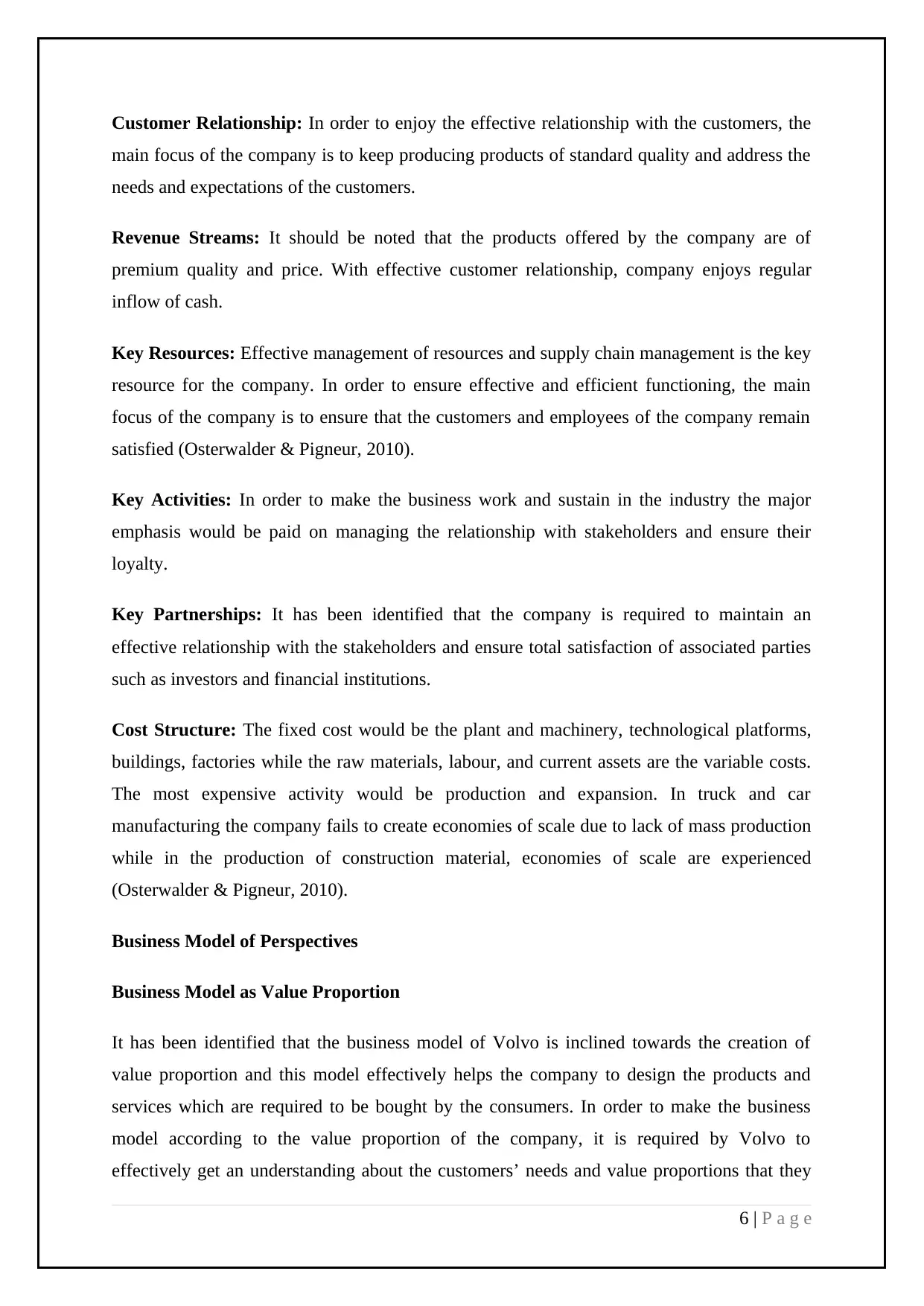
Customer Relationship: In order to enjoy the effective relationship with the customers, the
main focus of the company is to keep producing products of standard quality and address the
needs and expectations of the customers.
Revenue Streams: It should be noted that the products offered by the company are of
premium quality and price. With effective customer relationship, company enjoys regular
inflow of cash.
Key Resources: Effective management of resources and supply chain management is the key
resource for the company. In order to ensure effective and efficient functioning, the main
focus of the company is to ensure that the customers and employees of the company remain
satisfied (Osterwalder & Pigneur, 2010).
Key Activities: In order to make the business work and sustain in the industry the major
emphasis would be paid on managing the relationship with stakeholders and ensure their
loyalty.
Key Partnerships: It has been identified that the company is required to maintain an
effective relationship with the stakeholders and ensure total satisfaction of associated parties
such as investors and financial institutions.
Cost Structure: The fixed cost would be the plant and machinery, technological platforms,
buildings, factories while the raw materials, labour, and current assets are the variable costs.
The most expensive activity would be production and expansion. In truck and car
manufacturing the company fails to create economies of scale due to lack of mass production
while in the production of construction material, economies of scale are experienced
(Osterwalder & Pigneur, 2010).
Business Model of Perspectives
Business Model as Value Proportion
It has been identified that the business model of Volvo is inclined towards the creation of
value proportion and this model effectively helps the company to design the products and
services which are required to be bought by the consumers. In order to make the business
model according to the value proportion of the company, it is required by Volvo to
effectively get an understanding about the customers’ needs and value proportions that they
6 | P a g e
main focus of the company is to keep producing products of standard quality and address the
needs and expectations of the customers.
Revenue Streams: It should be noted that the products offered by the company are of
premium quality and price. With effective customer relationship, company enjoys regular
inflow of cash.
Key Resources: Effective management of resources and supply chain management is the key
resource for the company. In order to ensure effective and efficient functioning, the main
focus of the company is to ensure that the customers and employees of the company remain
satisfied (Osterwalder & Pigneur, 2010).
Key Activities: In order to make the business work and sustain in the industry the major
emphasis would be paid on managing the relationship with stakeholders and ensure their
loyalty.
Key Partnerships: It has been identified that the company is required to maintain an
effective relationship with the stakeholders and ensure total satisfaction of associated parties
such as investors and financial institutions.
Cost Structure: The fixed cost would be the plant and machinery, technological platforms,
buildings, factories while the raw materials, labour, and current assets are the variable costs.
The most expensive activity would be production and expansion. In truck and car
manufacturing the company fails to create economies of scale due to lack of mass production
while in the production of construction material, economies of scale are experienced
(Osterwalder & Pigneur, 2010).
Business Model of Perspectives
Business Model as Value Proportion
It has been identified that the business model of Volvo is inclined towards the creation of
value proportion and this model effectively helps the company to design the products and
services which are required to be bought by the consumers. In order to make the business
model according to the value proportion of the company, it is required by Volvo to
effectively get an understanding about the customers’ needs and value proportions that they
6 | P a g e
⊘ This is a preview!⊘
Do you want full access?
Subscribe today to unlock all pages.

Trusted by 1+ million students worldwide
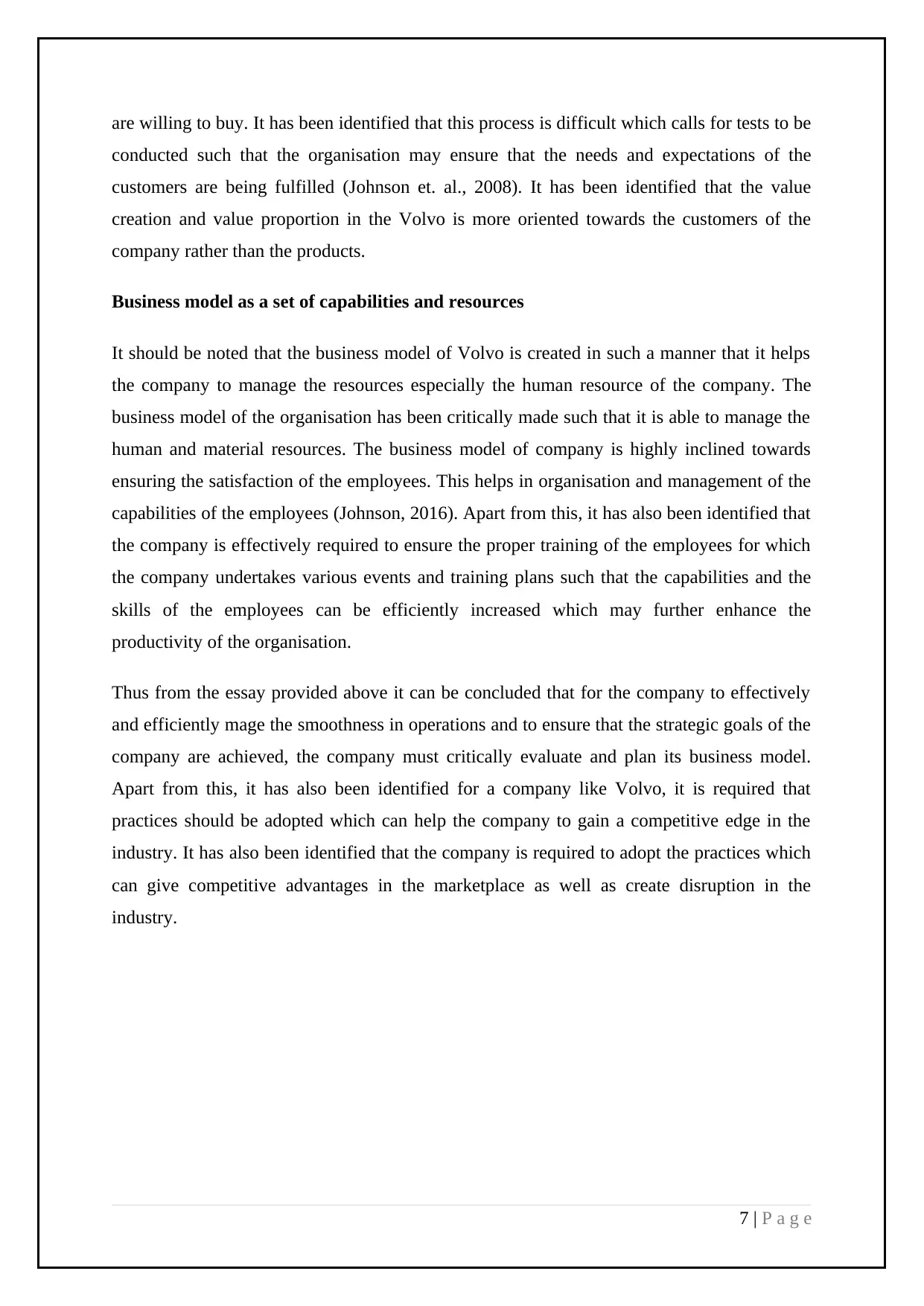
are willing to buy. It has been identified that this process is difficult which calls for tests to be
conducted such that the organisation may ensure that the needs and expectations of the
customers are being fulfilled (Johnson et. al., 2008). It has been identified that the value
creation and value proportion in the Volvo is more oriented towards the customers of the
company rather than the products.
Business model as a set of capabilities and resources
It should be noted that the business model of Volvo is created in such a manner that it helps
the company to manage the resources especially the human resource of the company. The
business model of the organisation has been critically made such that it is able to manage the
human and material resources. The business model of company is highly inclined towards
ensuring the satisfaction of the employees. This helps in organisation and management of the
capabilities of the employees (Johnson, 2016). Apart from this, it has also been identified that
the company is effectively required to ensure the proper training of the employees for which
the company undertakes various events and training plans such that the capabilities and the
skills of the employees can be efficiently increased which may further enhance the
productivity of the organisation.
Thus from the essay provided above it can be concluded that for the company to effectively
and efficiently mage the smoothness in operations and to ensure that the strategic goals of the
company are achieved, the company must critically evaluate and plan its business model.
Apart from this, it has also been identified for a company like Volvo, it is required that
practices should be adopted which can help the company to gain a competitive edge in the
industry. It has also been identified that the company is required to adopt the practices which
can give competitive advantages in the marketplace as well as create disruption in the
industry.
7 | P a g e
conducted such that the organisation may ensure that the needs and expectations of the
customers are being fulfilled (Johnson et. al., 2008). It has been identified that the value
creation and value proportion in the Volvo is more oriented towards the customers of the
company rather than the products.
Business model as a set of capabilities and resources
It should be noted that the business model of Volvo is created in such a manner that it helps
the company to manage the resources especially the human resource of the company. The
business model of the organisation has been critically made such that it is able to manage the
human and material resources. The business model of company is highly inclined towards
ensuring the satisfaction of the employees. This helps in organisation and management of the
capabilities of the employees (Johnson, 2016). Apart from this, it has also been identified that
the company is effectively required to ensure the proper training of the employees for which
the company undertakes various events and training plans such that the capabilities and the
skills of the employees can be efficiently increased which may further enhance the
productivity of the organisation.
Thus from the essay provided above it can be concluded that for the company to effectively
and efficiently mage the smoothness in operations and to ensure that the strategic goals of the
company are achieved, the company must critically evaluate and plan its business model.
Apart from this, it has also been identified for a company like Volvo, it is required that
practices should be adopted which can help the company to gain a competitive edge in the
industry. It has also been identified that the company is required to adopt the practices which
can give competitive advantages in the marketplace as well as create disruption in the
industry.
7 | P a g e
Paraphrase This Document
Need a fresh take? Get an instant paraphrase of this document with our AI Paraphraser
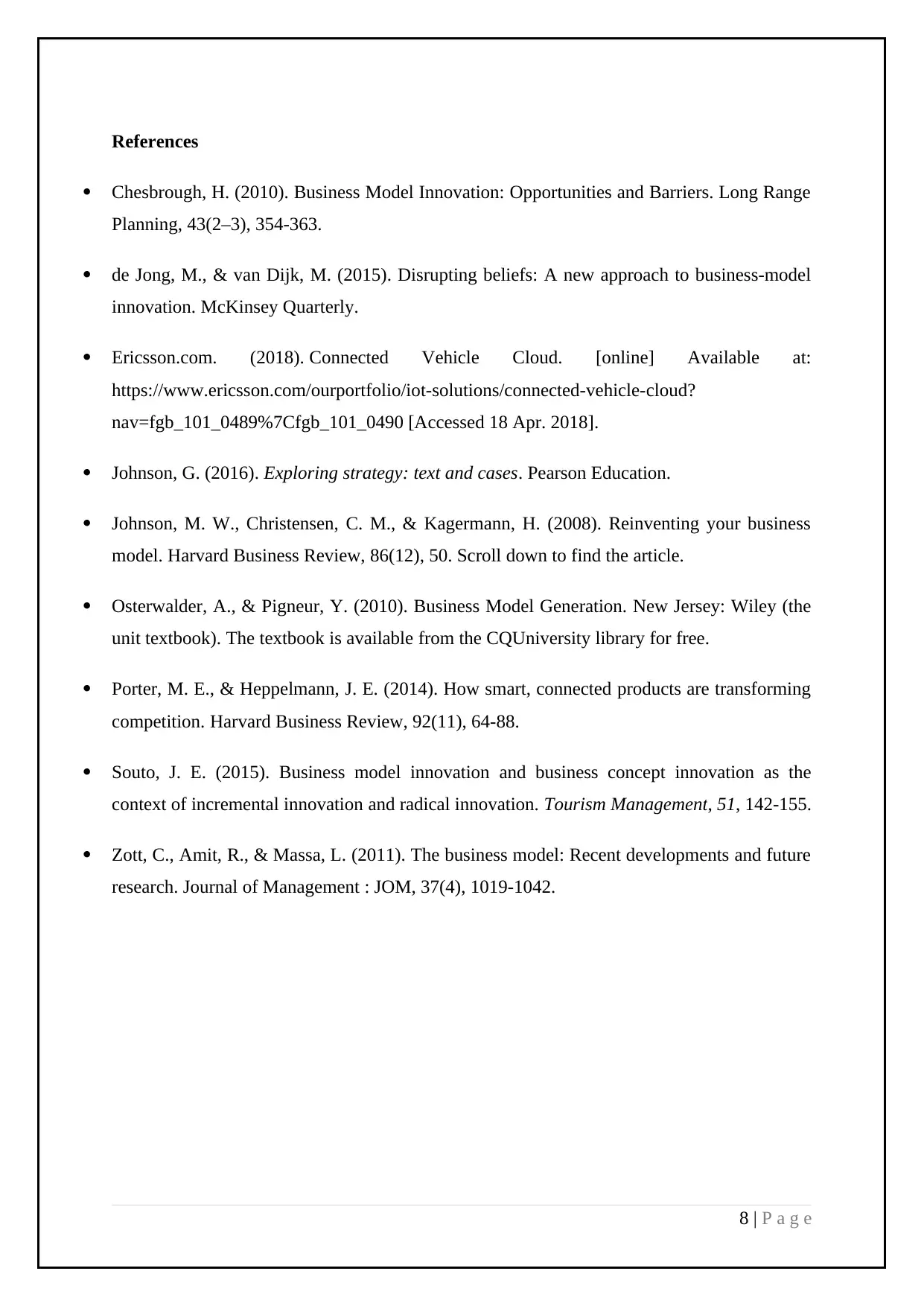
References
Chesbrough, H. (2010). Business Model Innovation: Opportunities and Barriers. Long Range
Planning, 43(2–3), 354-363.
de Jong, M., & van Dijk, M. (2015). Disrupting beliefs: A new approach to business-model
innovation. McKinsey Quarterly.
Ericsson.com. (2018). Connected Vehicle Cloud. [online] Available at:
https://www.ericsson.com/ourportfolio/iot-solutions/connected-vehicle-cloud?
nav=fgb_101_0489%7Cfgb_101_0490 [Accessed 18 Apr. 2018].
Johnson, G. (2016). Exploring strategy: text and cases. Pearson Education.
Johnson, M. W., Christensen, C. M., & Kagermann, H. (2008). Reinventing your business
model. Harvard Business Review, 86(12), 50. Scroll down to find the article.
Osterwalder, A., & Pigneur, Y. (2010). Business Model Generation. New Jersey: Wiley (the
unit textbook). The textbook is available from the CQUniversity library for free.
Porter, M. E., & Heppelmann, J. E. (2014). How smart, connected products are transforming
competition. Harvard Business Review, 92(11), 64-88.
Souto, J. E. (2015). Business model innovation and business concept innovation as the
context of incremental innovation and radical innovation. Tourism Management, 51, 142-155.
Zott, C., Amit, R., & Massa, L. (2011). The business model: Recent developments and future
research. Journal of Management : JOM, 37(4), 1019-1042.
8 | P a g e
Chesbrough, H. (2010). Business Model Innovation: Opportunities and Barriers. Long Range
Planning, 43(2–3), 354-363.
de Jong, M., & van Dijk, M. (2015). Disrupting beliefs: A new approach to business-model
innovation. McKinsey Quarterly.
Ericsson.com. (2018). Connected Vehicle Cloud. [online] Available at:
https://www.ericsson.com/ourportfolio/iot-solutions/connected-vehicle-cloud?
nav=fgb_101_0489%7Cfgb_101_0490 [Accessed 18 Apr. 2018].
Johnson, G. (2016). Exploring strategy: text and cases. Pearson Education.
Johnson, M. W., Christensen, C. M., & Kagermann, H. (2008). Reinventing your business
model. Harvard Business Review, 86(12), 50. Scroll down to find the article.
Osterwalder, A., & Pigneur, Y. (2010). Business Model Generation. New Jersey: Wiley (the
unit textbook). The textbook is available from the CQUniversity library for free.
Porter, M. E., & Heppelmann, J. E. (2014). How smart, connected products are transforming
competition. Harvard Business Review, 92(11), 64-88.
Souto, J. E. (2015). Business model innovation and business concept innovation as the
context of incremental innovation and radical innovation. Tourism Management, 51, 142-155.
Zott, C., Amit, R., & Massa, L. (2011). The business model: Recent developments and future
research. Journal of Management : JOM, 37(4), 1019-1042.
8 | P a g e
1 out of 8
Related Documents
Your All-in-One AI-Powered Toolkit for Academic Success.
+13062052269
info@desklib.com
Available 24*7 on WhatsApp / Email
![[object Object]](/_next/static/media/star-bottom.7253800d.svg)
Unlock your academic potential
Copyright © 2020–2025 A2Z Services. All Rights Reserved. Developed and managed by ZUCOL.




